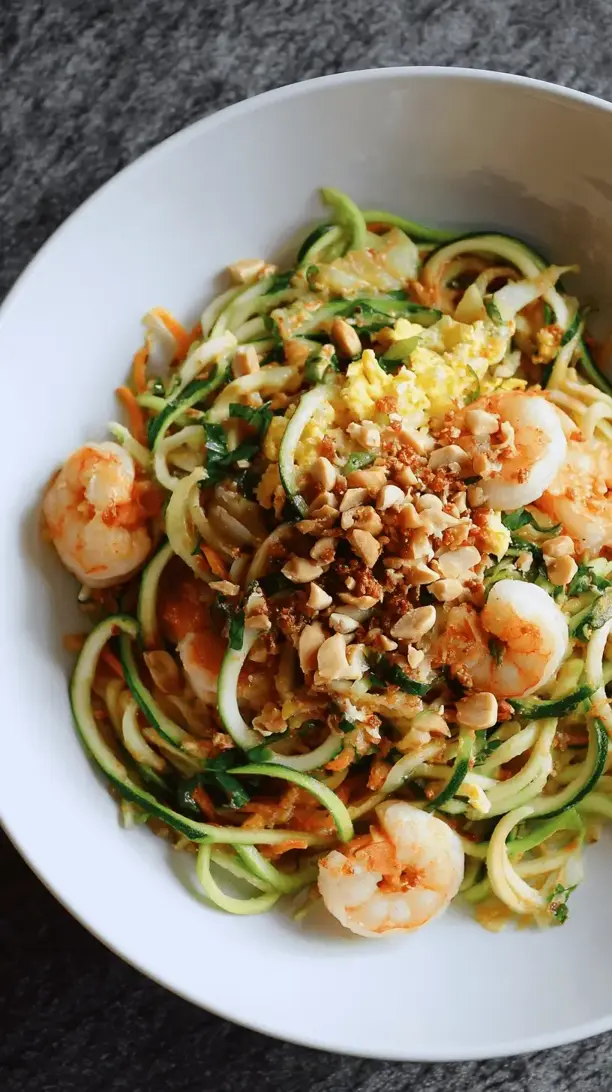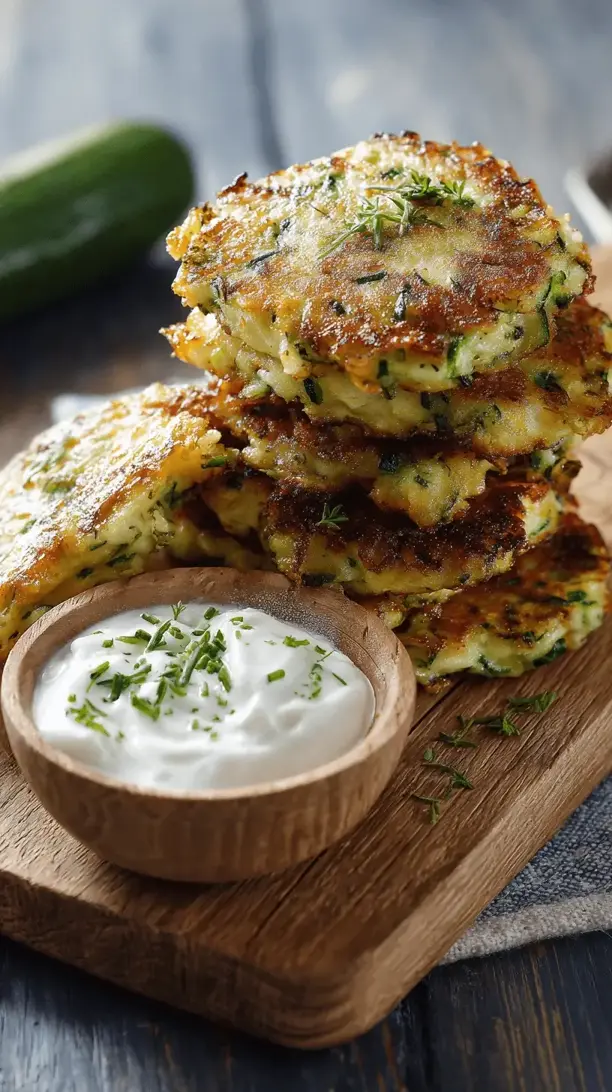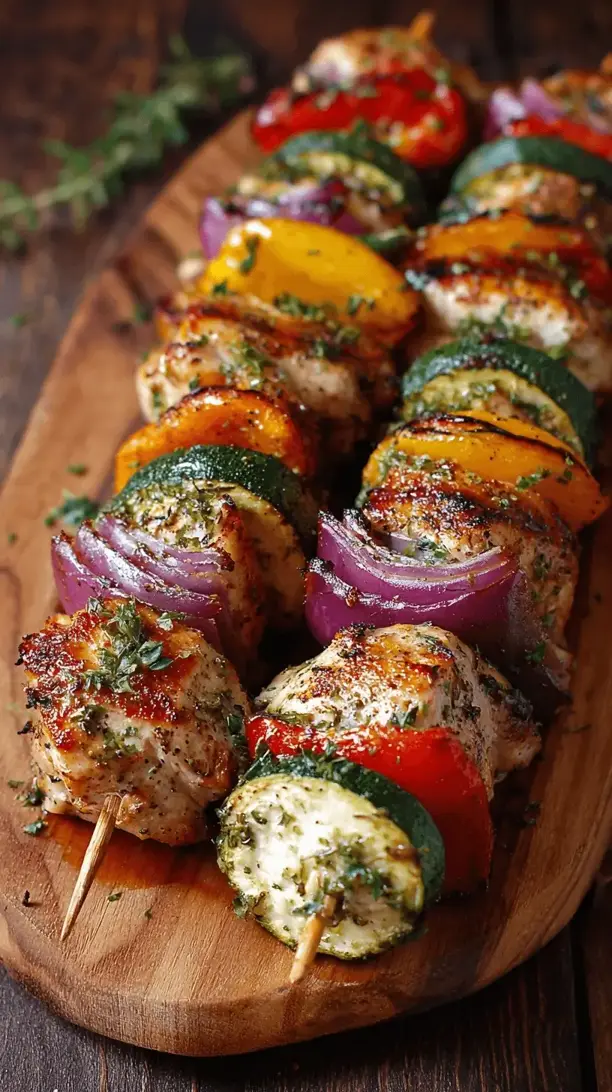Why You’ll Love This Zucchini Noodle Pad Thai
- It’s a flavor explosion in a bowl. We’re not holding back on the classic Pad Thai sauce here—tamarind, fish sauce, lime, and a touch of sweetness create that perfect balance that’s just so hard to resist.
- It feels incredibly light yet totally satisfying. Swapping traditional rice noodles for fresh zucchini spirals means you can have a generous, hearty portion that leaves you feeling energized, not sluggish.
- It’s seriously quick to make. From spiralizing to serving, you’re looking at about 20 minutes of active time. It’s faster than waiting for a delivery driver and infinitely more rewarding.
- It’s endlessly customizable. Not a fan of shrimp? Use chicken or tofu. Want more heat? Pile on the chili flakes. This recipe is a fantastic template for your own creations.
Ingredients & Tools
- 4 medium zucchinis, spiralized
- 2 tbsp avocado oil or coconut oil, divided
- 200 g raw shrimp, peeled and deveined (or chicken breast, thinly sliced, or firm tofu, cubed)
- 2 large eggs, lightly beaten
- 1 cup bean sprouts
- 3 green onions, sliced (whites and greens separated)
- 2 cloves garlic, minced
- 1/4 cup roasted peanuts, roughly chopped
- 1 lime, cut into wedges
- Fresh cilantro, for serving
- For the Sauce:
- 3 tbsp tamarind paste
- 3 tbsp fish sauce (or soy sauce/tamari for vegetarian)
- 2 tbsp rice vinegar
- 1.5 tbsp coconut sugar or brown sugar
- 1 tbsp fresh lime juice
- 1 tsp chili garlic sauce (or to taste)
Tools: A spiralizer (or julienne peeler), a large wok or skillet, a small bowl for the sauce.
The quality of your tamarind paste really makes a difference here—look for a pure, concentrated paste without too many additives for the most authentic flavor. And don’t skip the fresh lime wedges at the end; that squeeze of bright acidity right before eating is non-negotiable.
Serves: 2 | Prep Time: 15 mins | Cook Time: 10 mins | Total Time: 25 mins
Before You Start: Tips & Ingredient Notes
- Sweat those zoodles! Zucchini contains a lot of water. After spiralizing, toss the noodles with a pinch of salt and let them sit in a colander for 10-15 minutes. Then, press them gently with a clean kitchen towel to remove excess moisture. This prevents a watery sauce.
- Get your mise en place ready. Pad Thai cooks incredibly fast. Have all your ingredients chopped, your sauce mixed, and your plates ready to go before you even turn on the stove. It makes the process seamless and stress-free.
- Taste your tamarind paste. Some brands are more sour or sweet than others. Give it a quick taste and adjust the sugar or lime juice in the sauce accordingly before you add it to the wok.
- Don’t overcook the zucchini noodles. They only need a minute or two in the hot wok to warm through and soften slightly. You want them to retain a bit of a bite, or “al dente” texture, to mimic real noodles.
How to Make Zucchini Noodle Pad Thai
Step 1: First, let’s tackle the zucchini. Spiralize all four zucchinis into noodle-like strands. Place them in a colander set over a bowl or the sink, toss with a good pinch of salt, and let them sit while you prepare everything else. This is the perfect time to mix your sauce and chop your veggies. You’ll notice water starting to bead on the noodles—that’s exactly what we want.
Step 2: Whisk all the sauce ingredients—tamarind paste, fish sauce, rice vinegar, coconut sugar, lime juice, and chili garlic sauce—in a small bowl until the sugar is fully dissolved. Give it a taste! It should be a powerful balance of sweet, sour, salty, and spicy. Adjust to your preference, knowing it will mellow slightly when combined with the other ingredients.
Step 3: Now, heat 1 tablespoon of oil in a large wok or skillet over medium-high heat until it shimmers. Add your protein (shrimp, chicken, or tofu) and cook until just done—pink and opaque for shrimp, cooked through for chicken, golden for tofu. Transfer the cooked protein to a clean plate.
Step 4: Reduce the heat to medium and add the remaining tablespoon of oil to the same wok. Push the zucchini noodles with your hands or a clean kitchen towel to remove as much liquid as possible—this is the secret to a non-watery dish! Add the noodles, the white parts of the green onions, and the minced garlic to the wok. Toss constantly for just about 60-90 seconds until the garlic is fragrant and the zoodles are warmed and slightly softened.
Step 5: Push the zucchini noodle mixture to one side of the wok. Pour the beaten eggs onto the empty side. Let them set for about 30 seconds before scrambling them gently with your spatula until just cooked through.
Step 6: Now, return the cooked protein to the wok, along with the bean sprouts. Pour the prepared sauce over everything. Using tongs or two spatulas, toss everything together vigorously for another minute, ensuring every strand is coated in that glorious sauce. The sauce will heat through and thicken slightly as it coats the ingredients.
Step 7: Immediately remove the wok from the heat. Divide the Pad Thai between two bowls. Top generously with the green parts of the onions, the chopped peanuts, and a handful of fresh cilantro. Serve right away with lime wedges on the side for squeezing over the top. Dig in while it’s hot!
Serving Suggestions
Complementary Dishes
- A simple cucumber salad — Thinly sliced cucumbers with a quick dressing of rice vinegar, a pinch of sugar, and red chili flakes provides a cool, crisp contrast to the rich, warm noodles.
- Fresh summer rolls — If you’re feeling ambitious, these light, rice-paper-wrapped rolls filled with herbs and shrimp are a fantastic starter that continues the Southeast Asian theme without being heavy.
Drinks
- A crisp, dry Riesling — The slight sweetness and high acidity in the wine cut through the tangy-salty sauce beautifully, cleansing the palate between bites.
- An ice-cold Singha beer — You can’t go wrong with a classic Thai lager. Its light, crisp character is the perfect partner for the bold flavors of the dish.
Something Sweet
- Mango with sticky rice — The ultimate finale. Sweet, ripe mango paired with creamy coconut-infused sticky rice is a traditional and utterly satisfying way to end the meal.
- Lychee sorbet — A few scoops of this floral, refreshing sorbet are a light and elegant way to cleanse the palate and satisfy a sweet tooth after the savory main event.
Top Mistakes to Avoid
- Mistake: Skipping the salting step for the zucchini. This is the number one reason for a watery Pad Thai. The salt draws out the excess moisture, ensuring your sauce clings to the noodles instead of pooling at the bottom of the bowl. I’ve learned this the hard way!
- Mistake: Overcooking the zucchini noodles. They turn from perfectly tender to mushy in a flash. You really just want to warm them through and coat them in the sauce. Think of it as tossing, not cooking.
- Mistake: Adding the sauce too early. If you add the sauce before the eggs are cooked and everything is combined, it can make the eggs rubbery and cause the zoodles to release more water. The sauce should be the last thing to hit the pan for a quick toss.
- Mistake: Using old, clumpy tamarind paste. If your tamarind paste is dry or has hard bits, it won’t incorporate well. Soak it in a little warm water for 10 minutes, then push it through a sieve to get a smooth concentrate before measuring.
Expert Tips
- Tip: Make it a party. Set up a “Pad Thai Bar” for a fun dinner with friends. Have bowls of the prepped ingredients (cooked protein, salted zoodles, sauce, eggs, toppings) and let everyone cook their own portion in a skillet right at the table.
- Tip: Boost the umami. For an even deeper, savory flavor, add a teaspoon of shrimp paste to the sauce (toast it in the dry wok for a few seconds first) or a dash of soy sauce if you’re not using fish sauce.
- Tip: Prep ahead for ultra-fast meals. You can spiralize the zucchini and mix the sauce up to 2 days in advance. Store the zoodles in an airtight container in the fridge. Dinner will be on the table in under 10 minutes on a busy night.
- Tip: Get the wok screaming hot. A properly heated wok is key to that “wok hei” or breath of the wok—a slight smoky flavor. Don’t be afraid of high heat; just keep everything moving quickly once you start cooking.
FAQs
Can I make this Zucchini Noodle Pad Thai ahead of time?
Honestly, it’s best enjoyed fresh. The zucchini noodles will continue to release water as they sit, so the dish can become a bit soggy if made too far in advance. If you must, you can prep all the components separately—sauce, chopped veggies, cooked protein—and store them in containers in the fridge. Then, simply spiralize the zucchini fresh and toss everything together in a hot wok right before serving. The actual cooking process is so fast that this is a much better strategy than reheating a fully assembled dish.
I can’t find tamarind paste. What’s a good substitute?
This is a common dilemma! While tamarind has a unique sour-sweet flavor, you can create a decent stand-in. Mix equal parts fresh lime juice and rice vinegar (about 2 tbsp each) with a teaspoon of brown sugar. It won’t be exactly the same, but it will provide the necessary tangy-sweet balance. Another option is to use a tablespoon of Worcestershire sauce (it contains tamarind!) mixed with lime juice, though the flavor profile will shift slightly.
How can I make this recipe vegetarian or vegan?
It’s super easy! For vegetarian/vegan, simply swap the fish sauce for an equal amount of soy sauce or tamari. Use cubed firm tofu or tempeh as your protein. And finally, omit the egg or use a vegan egg substitute, or just add a bit more tofu. The core flavors of the sauce will still shine through beautifully.
My Pad Thai turned out watery. What happened?
This almost always comes down to the zucchini. The two key steps are salting and pressing the zoodles to draw out moisture *before* cooking, and then avoiding overcooking them *in* the wok. If you skipped the salting step, that’s likely the culprit. Also, make sure your wok is hot enough so that any residual liquid evaporates quickly during the final toss with the sauce.
Can I use a different vegetable for the noodles?
Absolutely! Sweet potato noodles (spiralized) would work well, though they’ll need a minute or two longer to cook. You could also use carrot noodles or a combination of zucchini and yellow squash. For a non-spiralized option, you can even use thinly sliced cabbage or kale as the base, though the cooking time and texture will be different. The sauce is so good, it’ll taste great on almost any veggie base.

Zucchini Noodle Pad Thai
Craving pad thai but want something lighter? My zucchini noodle version delivers all the sweet, salty, tangy magic in 25 minutes! Healthy, gluten-free, and totally customizable.
Ingredients
Ingredients
-
4 medium zucchinis (spiralized)
-
2 tbsp avocado oil or coconut oil (divided)
-
200 g raw shrimp (peeled and deveined (or chicken breast, thinly sliced, or firm tofu, cubed))
-
2 large eggs (lightly beaten)
-
1 cup bean sprouts
-
3 green onions (sliced (whites and greens separated))
-
2 cloves garlic (minced)
-
1/4 cup roasted peanuts (roughly chopped)
-
1 lime (cut into wedges)
-
Fresh cilantro (for serving)
-
3 tbsp tamarind paste
-
3 tbsp fish sauce (or soy sauce/tamari for vegetarian)
-
2 tbsp rice vinegar
-
1.5 tbsp coconut sugar or brown sugar
-
1 tbsp fresh lime juice
-
1 tsp chili garlic sauce (or to taste)
Instructions
-
First, let's tackle the zucchini. Spiralize all four zucchinis into noodle-like strands. Place them in a colander set over a bowl or the sink, toss with a good pinch of salt, and let them sit while you prepare everything else. This is the perfect time to mix your sauce and chop your veggies. You'll notice water starting to bead on the noodles—that's exactly what we want.01
-
Whisk all the sauce ingredients—tamarind paste, fish sauce, rice vinegar, coconut sugar, lime juice, and chili garlic sauce—in a small bowl until the sugar is fully dissolved. Give it a taste! It should be a powerful balance of sweet, sour, salty, and spicy. Adjust to your preference, knowing it will mellow slightly when combined with the other ingredients.02
-
Now, heat 1 tablespoon of oil in a large wok or skillet over medium-high heat until it shimmers. Add your protein (shrimp, chicken, or tofu) and cook until just done—pink and opaque for shrimp, cooked through for chicken, golden for tofu. Transfer the cooked protein to a clean plate.03
-
Reduce the heat to medium and add the remaining tablespoon of oil to the same wok. Push the zucchini noodles with your hands or a clean kitchen towel to remove as much liquid as possible—this is the secret to a non-watery dish! Add the noodles, the white parts of the green onions, and the minced garlic to the wok. Toss constantly for just about 60-90 seconds until the garlic is fragrant and the zoodles are warmed and slightly softened.04
-
Push the zucchini noodle mixture to one side of the wok. Pour the beaten eggs onto the empty side. Let them set for about 30 seconds before scrambling them gently with your spatula until just cooked through.05
-
Now, return the cooked protein to the wok, along with the bean sprouts. Pour the prepared sauce over everything. Using tongs or two spatulas, toss everything together vigorously for another minute, ensuring every strand is coated in that glorious sauce. The sauce will heat through and thicken slightly as it coats the ingredients.06
-
Immediately remove the wok from the heat. Divide the Pad Thai between two bowls. Top generously with the green parts of the onions, the chopped peanuts, and a handful of fresh cilantro. Serve right away with lime wedges on the side for squeezing over the top. Dig in while it's hot!07


